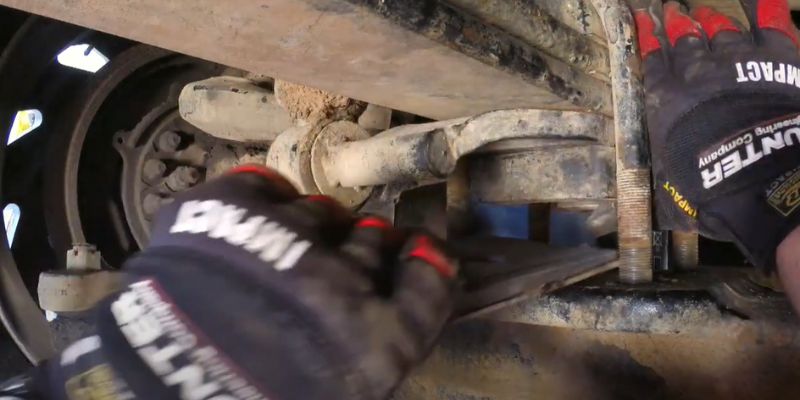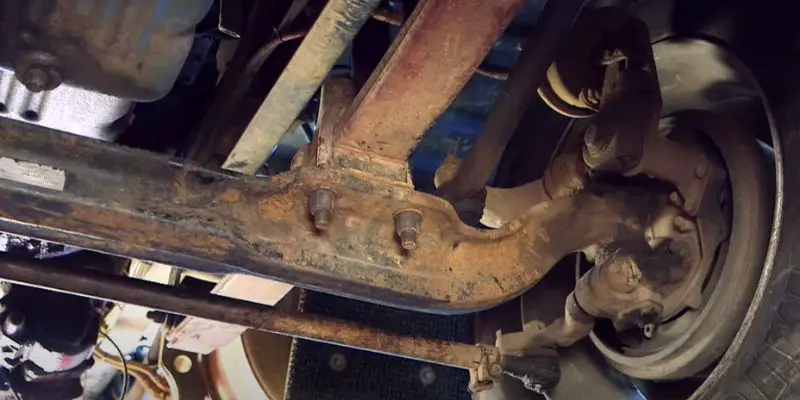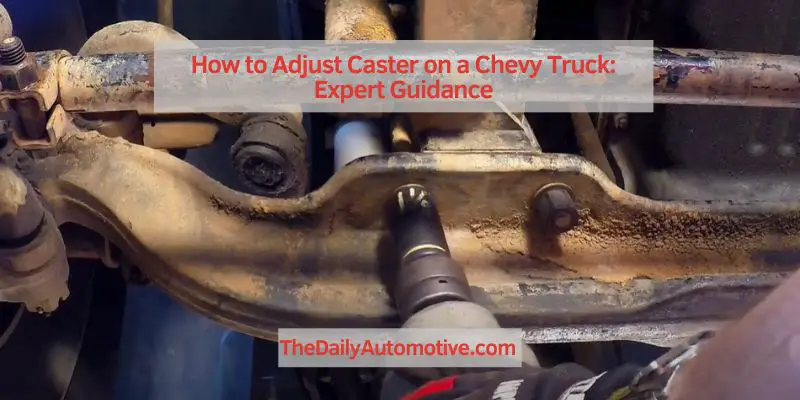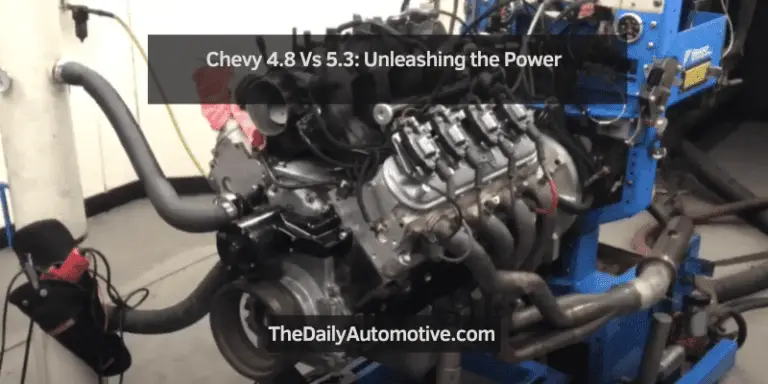How to Adjust Caster on a Chevy Truck: Expert Guidance
To adjust the caster on a Chevy truck, first, park the vehicle on a level surface and turn the steering wheel to access the adjustment bolts, located behind the front tires. Use a caster/camber gauge to measure the caster and make the necessary adjustments by loosening the adjustment bolts and turning the camber adjustment bolts to the desired position.
Then, tighten the bolts and recheck the caster to ensure it is within specifications. Adjusting the caster on a Chevy truck is an essential part of maintaining proper wheel alignment, which ensures even tire wear and stable handling. By following a few simple steps, you can adjust the caster angle to the manufacturer’s recommended specifications, improving your truck’s overall performance and safety.
We’ll guide you through the process of adjusting the caster on your Chevy truck, helping you maintain optimal wheel alignment and prolong the life of your tires.
Understanding Caster Adjustment
When it comes to ensuring your Chevy truck’s optimal performance and handling, adjusting the caster angle is a crucial task. Understanding caster angle and its impact on driving performance is essential for maintaining stability and steering control. In this guide, we will delve into the specifics of caster angle adjustment for Chevy trucks, shedding light on its significance and the steps involved in adjusting it.
What Is Caster Angle In A Vehicle?
The caster angle refers to the inclination of the steering axis viewed from the side of the vehicle. It is typically expressed in degrees and is either positive or negative. A positive caster angle tilts the steering axis toward the rear of the vehicle, while a negative caster angle tilts it toward the front. The caster angle plays a critical role in steering stability, straight-line tracking, and returnability of the steering wheel.
Impact Of Incorrect Caster On Driving Performance
An incorrect caster angle can significantly affect the driving performance of a Chevy truck. When the caster angle is off, it can lead to steering instability, uneven tire wear, and reduced steering wheel returnability. A positive caster angle provides better straight-line stability and self-centering steering, while a negative caster angle can result in poor steering response and reduced directional stability.

Preparing For Adjustment
Before adjusting the caster on your Chevy truck, it’s essential to ensure that you have the right tools and take necessary safety precautions. Proper preparation can help you carry out the adjustment effectively and safely.
Tools Required For Caster Adjustment
- Jack and jack stands
- Wheel chocks
- Adjustable wrench
- Tape measure
- Grease pencil
- Alignment tools (optional, but recommended)
Safety Precautions To Take Before Making Adjustments
- Ensure the truck is parked on a level surface.
- Chock the rear wheels to prevent movement.
- Use jack stands to support the front end of the truck before lifting it.
- Wear gloves and safety glasses to protect yourself during the adjustment process.
- Refer to the Chevy truck’s manual for specific safety instructions related to caster adjustment.
Step-by-step Caster Adjustment Process
Adjusting the caster angle on your Chevy truck is an essential step in maintaining proper wheel alignment, which in turn ensures stable and straight driving. By adjusting the caster angle, you can fine-tune the steering stability and control of your truck, especially when navigating rough terrain. Below, we’ll guide you through the step-by-step process for adjusting the caster angle on your Chevy truck.
Inspecting The Current Caster Angle
Before making any adjustments, it’s crucial to inspect the current caster angle of your Chevy truck. You can do this using a caster/camber gauge, which measures the angle of the steering axis. Ideally, the caster angle should fall within the manufacturer’s recommended specifications. If the angle deviates from the specified range, you’ll need to make the necessary adjustments to bring it back into alignment.
Techniques For Adjusting Caster Angle
There are several techniques for adjusting the caster angle of your Chevy truck, depending on the type of suspension system it has. Common methods include using shims and adjustable control arms.
Using Shims To Adjust The Caster
Shims are commonly used to adjust the caster angle on leaf-sprung solid front axle trucks. By adding or removing shims between the axle and the leaf springs, you can effectively alter the caster angle. To increase the caster angle, you’ll need to add shims. Conversely, to reduce the caster angle, you’ll remove shims.
How To Adjust Caster Using Adjustable Control Arms
For trucks equipped with a coil-sprung independent front suspension, adjustable control arms provide an efficient way to adjust the caster angle. These control arms feature threaded rod ends or eccentric bushings that allow you to precisely adjust the position of the control arms, thereby altering the caster angle as needed.
Testing And Verifying Adjustments
Testing and verifying adjustments after adjusting the caster angle on your Chevy truck is crucial to ensuring optimal performance and safety. Properly testing and confirming the new settings will help guarantee that the adjustments have been made accurately and that your vehicle is in the best condition for driving.
Importance Of Post-adjustment Testing
After making alterations to the caster on your Chevy truck, it’s essential to conduct thorough testing to ensure that the adjustments have been successfully implemented. Testing the new settings helps in identifying any potential issues that may have arisen, and it also allows you to fine-tune the adjustments for optimal performance.
Verifying The New Caster Angle
Verifying the new caster angle is a critical step in the adjustment process. To do this, use a digital angle gauge to measure the caster angle on both sides of the vehicle. Ensure that the readings match the desired specifications for your specific Chevy truck model. Adjust as necessary to achieve the correct caster angle on both sides for optimum performance.
Expert Tips And Best Practices
When it comes to ensuring optimal performance and handling of your Chevy truck, adjusting the caster angle is crucial. Whether you’re navigating through rugged off-road terrain or cruising on smooth highways, making precise adjustments can significantly enhance the drivability and stability of your vehicle. In this section, we’ll delve into expert tips and best practices, shedding light on fine-tuning caster for off-road vs. on-road driving and common mistakes to avoid during caster adjustments.

Fine-tuning Caster For Off-road Vs. On-road Driving
Fine-tuning the caster angle for off-road driving requires a different approach compared to on-road conditions. When venturing off the beaten path, it’s essential to adjust the caster angle to optimize stability and steering control. Here are some expert tips to consider when adjusting caster for off-road vs. on-road driving:
- Off-Road Driving: While off-roading, consider increasing the positive caster angle to enhance straight-line stability and minimize the risk of veering off course on uneven terrain.
- On-Road Driving: For on-road driving, aim to achieve a balanced caster angle that promotes smooth steering response and reduces excessive road vibrations.
Common Mistakes To Avoid During Caster Adjustments
However, certain mistakes can compromise the effectiveness of caster adjustments. Avoiding these common pitfalls is crucial for achieving the desired handling characteristics. Here’s a rundown of the most prevalent mistakes to steer clear of:
- Inaccurate Measurements: Failing to take precise measurements can lead to erroneous caster adjustments, impacting steering and tire wear.
- Overlooking Bushing Wear: Neglecting the condition of the suspension bushings can impede the effectiveness of caster adjustments and lead to premature component wear.
- Ignoring Wheel Alignment: Neglecting proper wheel alignment before adjusting the caster can result in suboptimal handling and compromised tire performance.
Frequently Asked Questions For How To Adjust Caster On A Chevy Truck
How Can I Tell If My Caster Is Off?
If your Chevy truck pulls to one side, experiences steering instability, or shows uneven tire wear, your caster may be off. A professional alignment check can precisely identify any caster issues.
Why Is Caster Adjustment Important For My Truck?
Caster adjustment affects steering stability, straight-line tracking, and tire wear. Correct caster improves handling and reduces tire wear, ensuring a smoother and safer driving experience for your Chevy truck.
Can I Adjust The Caster On My Chevy Truck Myself?
Caster adjustment requires specialized tools and knowledge. It’s recommended to have a qualified mechanic perform the adjustment to ensure precise and accurate alignment, ultimately maintaining the safety and performance of your Chevy truck.
Conclusion
To sum up, adjusting the caster on your Chevy truck is essential for maintaining proper wheel alignment. By following the steps outlined in this guide, you can ensure that your vehicle handles and performs optimally. Regularly checking and adjusting the caster will improve your driving experience and prolong the life of your truck’s tires and suspension components.








